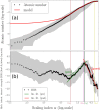Non-extensitivity and criticality of atomic hydropathicity around a voltage-gated sodium channel's pore: a modeling study
- PMID: 33735400
- PMCID: PMC7981368
- DOI: 10.1007/s10867-021-09565-w
Non-extensitivity and criticality of atomic hydropathicity around a voltage-gated sodium channel's pore: a modeling study
Erratum in
-
Correction to: Non-extensitivity and criticality of atomic hydropathicity around a voltage-gated sodium channel's pore: a modeling study.J Biol Phys. 2022 Dec;48(4):477-478. doi: 10.1007/s10867-022-09616-w. J Biol Phys. 2022. PMID: 36370323 Free PMC article. No abstract available.
Abstract
Voltage-gated sodium channels (NavChs) are pore-forming membrane proteins that regulate the transport of sodium ions through the cell membrane. Understanding the structure and function of NavChs is of major biophysical, as well as clinical, importance given their key role in cellular pathophysiology. In this work, we provide a computational framework for modeling system-size-dependent, i.e., cumulative, atomic properties around a NavCh's pore. We illustrate our methodologies on the bacterial NavAb channel captured in a closed-pore state where we demonstrate that the atomic environment around its pore exhibits a bi-phasic spatial organization dictated by the structural separation of the pore domains (PDs) from the voltage-sensing domains (VSDs). Accordingly, a mathematical model describing packing of atoms around NavAb's pore is constructed that allows-under certain conservation conditions-for a power-law approximation of the cumulative hydropathic dipole field effect acting along NavAb's pore. This verified the non-extensitivity hypothesis for the closed-pore NavAb channel and revealed a long-range hydropathic interactions law regulating atom-packing around the NavAb's selectivity filter. Our model predicts a PDs-VSDs coupling energy of [Formula: see text] kcal/mol corresponding to a global maximum of the atom-packing energy profile. Crucially, we demonstrate for the first time how critical phenomena can emerge in a single-channel structure as a consequence of the non-extensive character of its atomic porous environment.
Keywords: Criticality; Hydropathicity; NavAb; Non-extensitivity; Scaling; Voltage-gated sodium channels.
Conflict of interest statement
The authors have no competing interests.
Figures



Similar articles
-
Cumulative hydropathic topology of a voltage-gated sodium channel at atomic resolution.Proteins. 2020 Oct;88(10):1319-1328. doi: 10.1002/prot.25951. Epub 2020 Jun 13. Proteins. 2020. PMID: 32447794
-
Correction to: Non-extensitivity and criticality of atomic hydropathicity around a voltage-gated sodium channel's pore: a modeling study.J Biol Phys. 2022 Dec;48(4):477-478. doi: 10.1007/s10867-022-09616-w. J Biol Phys. 2022. PMID: 36370323 Free PMC article. No abstract available.
-
Ion conduction and conformational flexibility of a bacterial voltage-gated sodium channel.Proc Natl Acad Sci U S A. 2014 Mar 4;111(9):3454-9. doi: 10.1073/pnas.1320907111. Epub 2014 Feb 18. Proc Natl Acad Sci U S A. 2014. PMID: 24550503 Free PMC article.
-
Emerging issues of connexin channels: biophysics fills the gap.Q Rev Biophys. 2001 Aug;34(3):325-472. doi: 10.1017/s0033583501003705. Q Rev Biophys. 2001. PMID: 11838236 Review.
-
Molecular pore structure of voltage-gated sodium and calcium channels.Braz J Med Biol Res. 1994 Dec;27(12):2781-802. Braz J Med Biol Res. 1994. PMID: 7550000 Review.
Cited by
-
Hydropathicity-based prediction of pain-causing NaV1.7 variants.BMC Bioinformatics. 2021 Apr 23;22(1):212. doi: 10.1186/s12859-021-04119-2. BMC Bioinformatics. 2021. PMID: 33892629 Free PMC article.
-
Worldwide Sodium Channel Conference, January 31st-February 2nd, 2024, Grindelwald, Switzerland.Bioelectricity. 2024 Dec 13;6(4):288-291. doi: 10.1089/bioe.2024.0025. eCollection 2024 Dec. Bioelectricity. 2024. PMID: 39712211
-
Generalizing the Wells-Riley Infection Probability: A Superstatistical Scheme for Indoor Infection Risk Estimation.Entropy (Basel). 2023 Jun 2;25(6):896. doi: 10.3390/e25060896. Entropy (Basel). 2023. PMID: 37372240 Free PMC article.
References
-
- Hille B. Ionic Channels of Excitable Membranes. 3rd edn. Sunderland MA: Sinauer Associates Inc.; 2001.
-
- Harty TP, Dib-Hajj SD, Tyrrell L, Blackman R, Hisama FM, Rose JB, Waxman SG. NaV1.7 mutant A863P in erythromelalgia: effects of altered activation and steady-state inactivation on excitability of nociceptive dorsal root ganglion neurons. J. Neurosci. 2006;26:12566–12575. doi: 10.1523/JNEUROSCI.3424-06.2006. - DOI - PMC - PubMed
Publication types
MeSH terms
Substances
Grants and funding
LinkOut - more resources
Full Text Sources
Other Literature Sources
Miscellaneous

